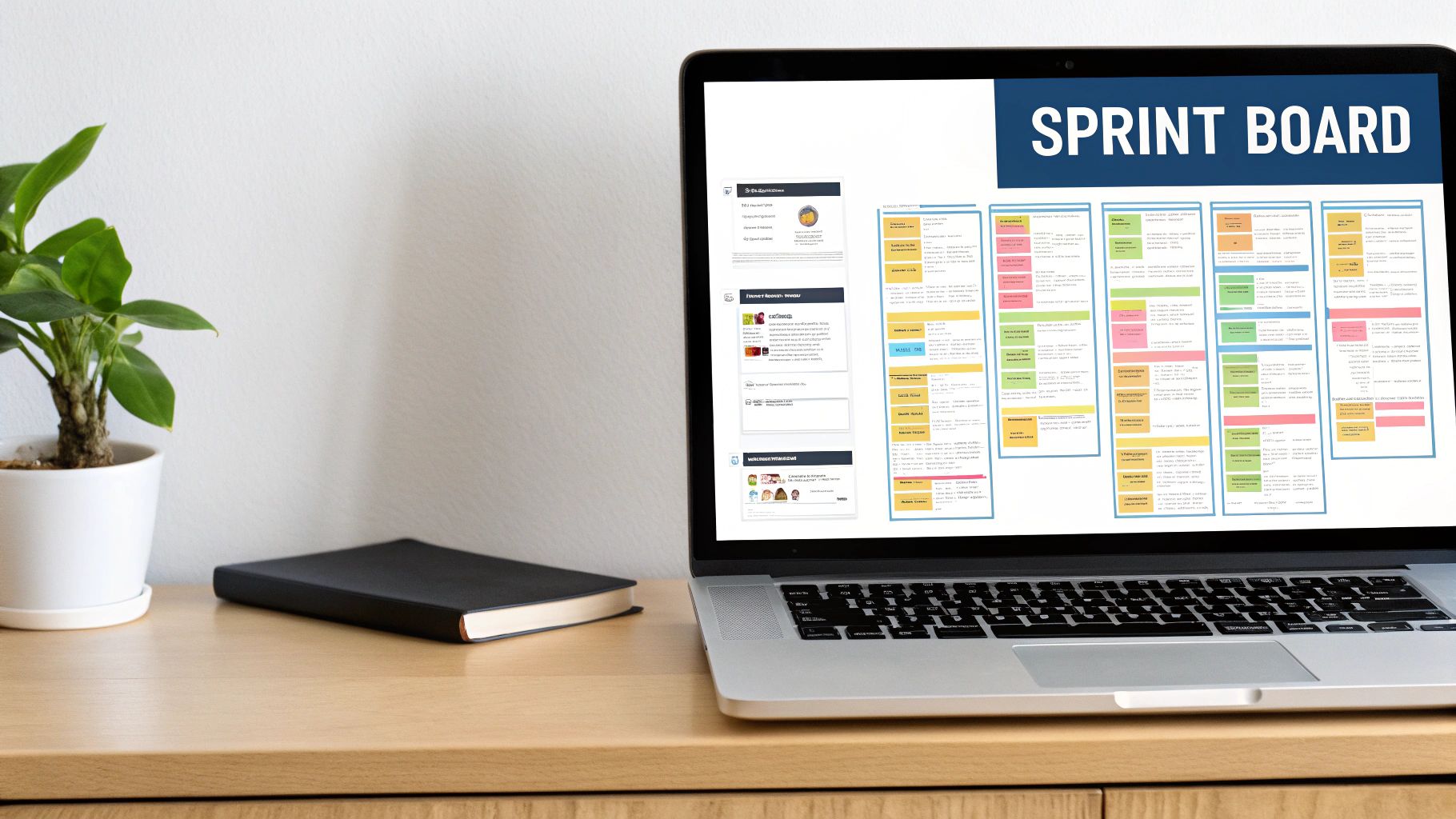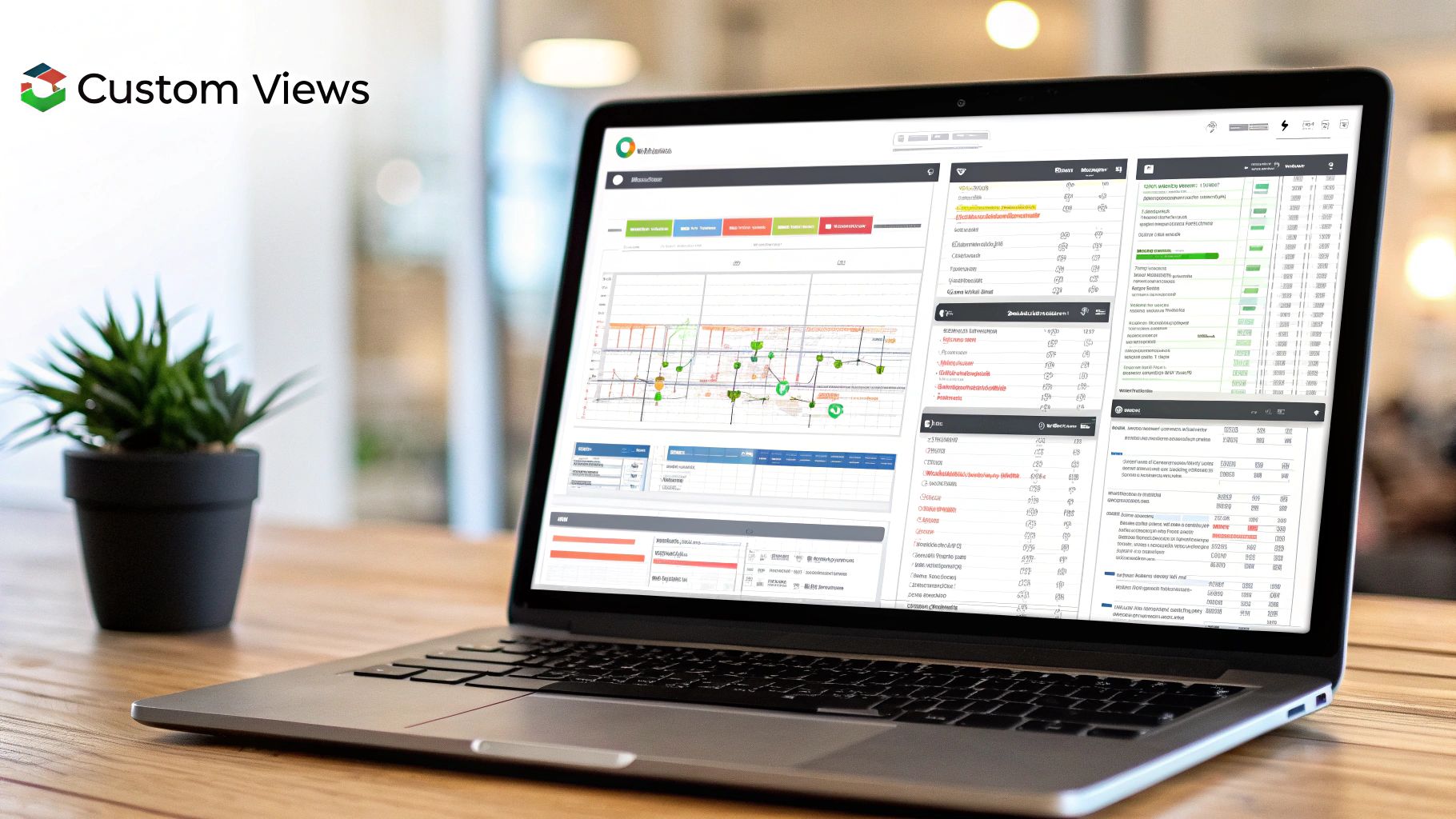sprint planning template
agile development
scrum tools
project management
6 Best Sprint Planning Template Options for 2025
Beyond the Backlog: Choosing Your Next Sprint Planning Template
Sprint planning is the cornerstone of any successful Agile team, turning a prioritized backlog into an actionable plan for the upcoming iteration. The right sprint planning template is more than just a document; it's a strategic tool that aligns teams, clarifies objectives, and sets the pace for execution. However, with countless methodologies and digital tools available, from the enterprise-grade structure of Jira to the visual collaboration of Miro, selecting the perfect fit can be a project in itself. This guide cuts through the noise.
We will provide a detailed roundup of the top sprint planning template options available today. We'll explore the unique strengths, ideal use cases, and practical implementation details for each one. This ensures you can select a framework that not only organizes work but fundamentally enhances your team's agility and output. For teams evaluating these templates, it's also helpful to consider how they integrate with broader tools for Agile Project Management that facilitate crucial ceremonies like daily stand-ups. Get ready to find the template that will propel your team’s productivity.
1. Atlassian Jira Sprint Planning Template
Atlassian’s Jira is a dominant force in project management, and its integrated sprint planning template is a primary reason for its widespread adoption. This isn't just a static document; it's a dynamic framework woven directly into the Jira ecosystem. It provides a structured, digital environment where teams can manage their product backlog, estimate effort, plan capacity, and commit to a clear sprint goal within a single, unified interface. This comprehensive integration makes it an enterprise-grade solution for teams aiming to streamline their Agile workflows.

The power of this template lies in its direct connection to Jira's core functionalities. Tasks from the backlog are dragged and dropped into the active sprint, with real-time updates to team capacity and workload visible to everyone. This transparency is crucial for setting realistic sprint goals and preventing team burnout.
Why It's a Top Choice
Jira’s template excels in complex environments where multiple teams collaborate. For instance, NASA's Jet Propulsion Laboratory uses Jira to manage sprints for mission-critical software, ensuring every component is tracked meticulously. Similarly, Spotify has famously adapted Jira's framework to fit its "squad" model, demonstrating its high degree of customizability. The platform’s ability to handle dependencies across teams, generate detailed velocity reports, and integrate with thousands of third-party apps makes it a versatile powerhouse.
Actionable Implementation Tips
To get the most out of your Jira sprint planning template, consider these practical steps:
- Establish Clear Story Point Definitions: Before your first sprint, your team must agree on what a story point represents. Is it complexity, effort, or time? Document this definition in a shared space like Confluence and use it consistently to ensure reliable velocity metrics.
- Utilize Jira Automation: Reduce administrative overhead by setting up automation rules. For example, you can create a rule that automatically moves a task to the "In Review" column when a developer creates a pull request in an integrated tool like Bitbucket or GitHub.
- Start Simple, Then Customize: Begin with Jira’s default Scrum or Kanban board templates. After a few sprints, use retrospective feedback to customize workflows, add custom fields (e.g., "Priority Level," "Customer Impact"), and adjust board columns to match your team’s actual process.
- Regularly Archive Old Sprints: To keep your board running smoothly and your backlog manageable, make it a habit to close and archive completed sprints. This prevents performance degradation and keeps the focus on current and future work.
This sprint planning template is ideal for established development teams, large organizations, and any project requiring rigorous tracking and reporting. Its steep learning curve can be a challenge for smaller teams, but for those who need robust, scalable Agile tooling, Jira is often the definitive choice.
Learn more at the Atlassian Jira Website.
2. Scrum.org Official Sprint Planning Template
For teams committed to practicing Scrum by the book, the official template and guidelines from Scrum.org are the gold standard. Co-created by Scrum visionaries like Ken Schwaber and Jeff Sutherland, this framework isn't just a document; it’s a direct reflection of the principles outlined in the official Scrum Guide. It emphasizes collaboration, timeboxing, and outcome-driven planning, ensuring every sprint planning session is purposeful and aligned with core Agile values. This approach provides a blueprint for conducting a planning meeting that produces a valuable, achievable Sprint Goal.
The strength of the Scrum.org approach lies in its purity and focus on the "why" behind the work. It guides teams to answer three critical questions during planning: Why is this Sprint valuable? What can be Done this Sprint? How will the chosen work get done? This structured dialogue ensures the team creates a plan, not just a list of tasks, fostering a deep sense of ownership and commitment to the sprint's objectives.
Why It's a Top Choice
The Scrum.org framework is renowned for its effectiveness in fostering true Agile maturity. For instance, Microsoft's Azure DevOps teams have leveraged Scrum.org methodologies to structure their sprints, enabling them to ship complex features with high predictability. Similarly, Salesforce has integrated these official practices across its R&D divisions to maintain alignment and quality at scale. 3M Company even adopted these principles to guide its large-scale digital transformation initiatives, highlighting the template's power to instill Agile discipline in complex corporate environments.
Actionable Implementation Tips
To effectively implement this sprint planning template, consider these foundational practices:
- Solidify the Definition of Done (DoD): Before a single user story is discussed, the entire team must have a shared, crystal-clear understanding of the DoD. This document defines the quality standard for all work and is non-negotiable. Revisit and refine it in your retrospectives.
- Apply the 'INVEST' Criteria to User Stories: Ensure every Product Backlog Item selected for the sprint is well-formed. Stories should be Independent, Negotiable, Valuable, Estimable, Small (appropriately sized), and Testable. This prevents ambiguity and ensures a smooth workflow.
- Prioritize Business Value: The Product Owner should guide the team to focus on the "why." Constantly ask, "How does this work contribute to the product goal and deliver value to our stakeholders?" This keeps the plan customer-centric and impactful.
- Use Retrospectives to Refine Planning: Treat your sprint planning process itself as an item for improvement. During each Sprint Retrospective, ask what went well in the last planning session and what could be done better. This iterative improvement is a core tenet of Scrum.
This approach is ideal for teams new to Scrum who want to build a strong foundation, as well as for experienced teams looking to realign with core principles. It is less about a specific tool and more about a disciplined mindset, making it universally applicable.
Learn more at the Scrum.org Website.
3. Scaled Agile Framework (SAFe) Sprint Planning Template
The Scaled Agile Framework (SAFe) offers a sprint planning template designed not for a single team, but for an entire enterprise. This framework addresses the immense challenge of coordinating multiple Agile teams working in unison on large-scale, complex solutions. Unlike standalone team-level templates, the SAFe approach integrates planning across team, program, and even portfolio levels. It provides the structure necessary to align dozens of teams toward a shared set of objectives within a Program Increment (PI), which is essentially a larger timebox (typically 8-12 weeks) containing multiple sprints.
This model is fundamentally about creating alignment and managing dependencies in complex environments. A SAFe sprint planning template is less a single document and more a system of interconnected planning artifacts, including team backlogs, a program board, and risk registers. This structured approach ensures that every team's sprint plan contributes directly to the larger program goals, making it an indispensable tool for organizations committed to enterprise-wide agility.
Why It's a Top Choice
SAFe excels where other Agile methods falter: at scale. Its structured, multi-layered planning process is critical for industries with high compliance and integration needs. For example, Boeing utilizes SAFe principles to coordinate vast software development efforts across its aircraft programs, ensuring that components developed by different teams integrate seamlessly. Similarly, Philips Healthcare applies SAFe methodologies to manage the intricate software development for its medical devices, where safety and regulatory compliance are paramount. The framework's emphasis on dependency mapping and risk mitigation during PI Planning is essential for preventing costly delays and integration failures in such high-stakes environments.
Actionable Implementation Tips
Adopting a SAFe sprint planning template requires a significant organizational commitment. Follow these steps for a smoother transition:
- Start with Essential SAFe: SAFe has multiple configurations. Begin with "Essential SAFe," the most basic version. This allows your organization to learn the core practices of PI Planning and team-level Agile without being overwhelmed by the portfolio and large solution layers.
- Invest in Comprehensive Training: SAFe introduces new roles (like Release Train Engineer) and events (like PI Planning). Ensure all stakeholders, from executives to individual team members, receive proper training from certified professionals to build a shared understanding and vocabulary.
- Use SAFe-Native Digital Tools: While you can adapt standard tools, platforms like Jira Align, Planview, or Broadcom's Rally are built specifically to support SAFe. These tools make managing program boards, dependencies, and objectives far more efficient than manual spreadsheets. For those exploring similar structured software solutions, these platforms provide valuable insight into how enterprise-level tools are built. For inspiration on building your own specialized tools, check out some micro-saas ideas.
- Establish Clear Communication Protocols: Create formal communication channels between the program level (Product Management, System Architects) and the team level (Product Owners, developers). This ensures that strategic goals are clearly translated into sprint backlogs and that team-level impediments are quickly escalated.
This template is best suited for large enterprises, government agencies, and organizations with multiple interdependent development teams. It is overkill for small companies or single-team projects, but for those needing to synchronize a large Agile workforce, SAFe provides a proven and robust solution.
Learn more at the Scaled Agile Framework Website.
4. Microsoft Azure DevOps Sprint Planning Template
Microsoft's Azure DevOps offers a powerful, integrated sprint planning template built directly into its comprehensive suite of developer services. More than just a document, it is a dynamic hub connecting every phase of the development lifecycle. This template provides a unified environment for managing backlogs, planning sprints, tracking work items, and linking progress directly to source code and CI/CD pipelines. Its seamless integration with the broader Microsoft ecosystem makes it a go-to choice for teams heavily invested in Azure and Visual Studio.
The strength of this sprint planning template lies in its end-to-end traceability. A user story or bug can be planned in a sprint, linked to a specific code branch, tracked through pull requests, and automatically updated as it moves through build and release pipelines. This creates a single source of truth, eliminating information silos and providing unparalleled visibility into the development process.
Why It's a Top Choice
Azure DevOps excels in enterprise environments that require tight integration between planning, development, and operations. For example, the global shipping giant Maersk Line implemented Azure DevOps templates to coordinate its complex logistics software development, enabling better alignment across distributed teams. Similarly, Stack Overflow leverages the platform for its own development sprint planning, benefiting from its robust work item tracking and repository integration. The template's ability to provide granular control and deep analytics makes it a cornerstone for data-driven engineering teams.
Actionable Implementation Tips
To effectively utilize the Microsoft Azure DevOps sprint planning template, implement these targeted strategies:
- Leverage the Query System: Create custom, shareable queries to build powerful sprint reports and dashboards. For instance, you can design a query that shows all high-priority bugs assigned to a specific sprint that have not yet been linked to a pull request, giving you a precise view of potential bottlenecks.
- Use Work Item Templates: Standardize the creation of user stories, bugs, and tasks by creating work item templates. You can pre-populate fields like "Area Path," "Iteration Path," "Tags," and acceptance criteria, ensuring consistency and saving your team valuable time during backlog grooming and sprint planning.
- Integrate with Microsoft Teams: Enhance collaboration by integrating Azure DevOps with Microsoft Teams. Configure notifications to post updates about work item changes, pull requests, and build statuses directly into a team channel, keeping everyone informed in real-time without leaving their primary communication tool.
- Explore the Visual Studio Marketplace: Extend the template’s functionality with extensions. The marketplace offers hundreds of tools, from advanced estimation poker widgets to custom reporting integrations, allowing you to tailor the platform precisely to your team’s workflow.
This sprint planning template is ideal for development teams operating within the Microsoft ecosystem, large enterprises requiring robust governance, and any project where deep integration with CI/CD is a priority. While it may feel overly complex for non-development projects, it provides a cohesive and powerful solution for modern software teams.
Explore how this and other tools fit into a modern tech stack. Learn more about the B2B SaaS landscape.
5. Miro Agile Sprint Planning Template
Miro’s Agile Sprint Planning Template reimagines the sprint planning process as a dynamic, visual, and highly collaborative workshop. Rather than a rigid list of tasks, Miro provides an infinite digital whiteboard where teams can use sticky notes, diagrams, and voting tools to map out their sprint. This approach moves beyond simple task management, fostering creative problem-solving, shared understanding, and active engagement from every team member in a way that traditional tools often cannot. It's a sprint planning template designed for visual thinkers and remote-first teams who thrive on interaction.

The strength of Miro's template lies in its ability to centralize communication and context. Teams can conduct backlog grooming, story point estimation using planning poker, and capacity planning all on one board, keeping conversations and decisions visually anchored to the work items. This makes complex discussions more intuitive and inclusive, especially for distributed teams.
Why It's a Top Choice
Miro excels in environments that prioritize creative collaboration and cross-functional alignment. For instance, Netflix's creative teams use Miro boards for brainstorming and sprint planning on promotional campaigns, ensuring marketing, design, and content are perfectly in sync. Similarly, organizations like Airbnb leverage Miro for cross-functional workshops that bring together product, engineering, and design to plan sprints collectively. Its flexibility allows teams to blend different Agile frameworks, making it a favorite in companies like Spotify, which incorporate visual planning into their squad-level ceremonies.
Actionable Implementation Tips
To effectively use the Miro Agile Sprint Planning Template, implement these strategies:
- Establish Clear Facilitation Guidelines: For remote or hybrid sessions, designate a facilitator and set ground rules. Use Miro's timer for timeboxing activities like estimation or brainstorming to keep the meeting focused and on schedule.
- Use Color-Coding and Tags: Assign specific colors to different work types (e.g., bug, feature, chore) or priority levels. Use tags to link user stories to specific epics or strategic goals, making the board instantly scannable and easy to understand.
- Integrate with Your Task Manager: Connect your Miro board to tools like Jira or Azure DevOps. This allows you to convert digital sticky notes into formal work items with a single click, eliminating double entry and ensuring your visual plan is synced with your system of record.
- Create Team-Specific Variations: Start with the standard template, but empower your team to customize it. After a few sprints, use retrospective feedback to add or remove sections, creating a bespoke sprint planning template that perfectly matches your team’s unique workflow.
This template is ideal for remote or hybrid teams, creative agencies, and any organization looking to make its sprint planning meetings more interactive and engaging. While it may not replace a dedicated project management tool for execution, it serves as an unparalleled collaborative hub for the planning phase itself.
Learn more at the Miro Website.
6. ClickUp Sprint Planning Template
ClickUp positions itself as the "one app to replace them all," and its sprint planning template embodies this philosophy by offering a highly flexible, all-in-one workspace. This template moves beyond rigid Agile frameworks to provide a solution that combines traditional sprint planning with modern productivity features. It offers extensive customization and multiple views, including Kanban, Gantt, and Calendar, allowing teams to visualize their sprints in the way that works best for them, all within a single, unified platform.

The core strength of the ClickUp template is its adaptability. Teams are not locked into a single methodology. Whether you are running a strict Scrum process or a hybrid "Scrumban" model, the template can be configured to match your workflow. This versatility makes it an excellent choice for dynamic teams whose processes evolve over time.
Why It's a Top Choice
ClickUp's template is particularly powerful for organizations that need to centralize disparate workflows. For example, Google's internal teams have adopted ClickUp for sprint planning in various departments, valuing its ability to consolidate tasks, documents, and goals. Similarly, Booking.com implements ClickUp templates to streamline their Agile development processes, and Uber uses it to coordinate sprint planning across different product teams. The platform's integrated goal-setting feature also allows teams to directly link sprint objectives to broader company OKRs, ensuring alignment.
Actionable Implementation Tips
To effectively leverage the ClickUp sprint planning template, focus on customization and automation from the start:
- Start with a Pre-Built Template: ClickUp offers numerous sprint-related templates. Begin with a pre-built one that most closely matches your needs and then gradually customize it. Modify statuses, add custom fields, and adjust views after each retrospective based on team feedback.
- Use the ClickUp Hierarchy: Master ClickUp's hierarchy (Spaces > Folders > Lists > Tasks) to organize complex projects. For instance, create a "Development" Space, a "Q3 Sprints" Folder, and then individual Lists for each sprint (e.g., "Sprint 23-A"). This keeps work neatly segmented and easy to navigate.
- Leverage Automation for Sprint Setup: Drastically reduce administrative work by automating repetitive sprint tasks. Create an automation rule that duplicates your sprint planning list at the end of each cycle, automatically assigns tasks to the team lead for review, and archives the completed sprint.
- Integrate Goals with Sprints: Use the platform's native "Goals" feature to define clear sprint objectives. Break down a goal into measurable targets and link relevant tasks from your sprint directly to those targets. This makes progress toward the sprint goal visible and quantifiable.
This sprint planning template is ideal for small to medium-sized businesses, startups, and productivity-focused teams that desire a single platform for all their work. Its vast feature set can be overwhelming initially, but for those willing to invest time in setup, it offers a level of integration and customization that few other tools can match. For startups looking to build strong foundations, pairing this template with a startup idea validator tool can help ensure sprints are focused on market-validated features.
Learn more at the ClickUp Website.
Sprint Planning Templates Comparison
| Template | Implementation Complexity 🔄 | Resource Requirements ⚡ | Expected Outcomes 📊 | Ideal Use Cases 💡 | Key Advantages ⭐ |
|---|---|---|---|---|---|
| Atlassian Jira Sprint Planning | High - Setup and configuration intensive | High - Requires licensing and technical setup | Strong sprint tracking, velocity, and reporting | Medium to large Agile teams with complex projects | Seamless dev tool integration; scalable; extensive reporting |
| Scrum.org Official Sprint Planning | Medium - Framework-driven but structured | Moderate - Training recommended | Strict Scrum compliance, clear sprint goals | Teams strictly following Scrum with certification goals | Globally recognized standards; collaborative; platform-agnostic |
| SAFe Sprint Planning | Very High - Complex multi-level coordination | Very High - Needs organization-wide adoption | Team & program alignment, risk management | Large enterprises coordinating multiple Agile teams | Enterprise scale; risk & dependency management; governance |
| Microsoft Azure DevOps Sprint | Medium - Integrated in Microsoft ecosystem | Moderate - Optimal in MS stack environments | End-to-end sprint and deployment management | Microsoft-centric development teams | Strong security; MS platform integration; extensive APIs |
| Miro Agile Sprint Planning | Low to Medium - Easy visual setup | Low - Primarily collaborative tool | Enhanced visual collaboration for planning | Remote/hybrid teams needing visual facilitation | Visual and interactive; easy for non-technical users |
| ClickUp Sprint Planning | Medium to High - Flexible and customizable | Moderate - Subscription with extensive features | Highly customizable sprint plans and reporting | SMBs and teams seeking versatile project management | Multi-view, flexible, automated reporting, mobile app |
From Planning to Production: Implementing Your Chosen Template
Selecting the perfect sprint planning template is a significant milestone, but the true measure of its success lies in its implementation. Throughout this guide, we've explored a curated selection of powerful templates, each with unique strengths. From the deep ecosystem integration of Jira and Azure DevOps to the methodological purity of Scrum.org and the enterprise-level orchestration of SAFe, you have a diverse toolkit at your disposal. For teams that thrive on visual collaboration, Miro offers unparalleled flexibility, while ClickUp provides a comprehensive, all-in-one solution for managing every facet of your workflow.
The core takeaway is that no single template is universally superior. Your choice should be a strategic one, directly reflecting your team's specific context. A small startup might find the lightweight, visual nature of a Miro board ideal for rapid ideation, whereas a large organization with complex dependencies will likely benefit from the structured, scalable framework offered by SAFe or Jira. The most effective sprint planning template is the one that your team will actually use consistently and enthusiastically.
Turning Plans into Actionable Sprints
Once you've made your choice, the real work begins. Here are the actionable next steps to transform your chosen template from a static document into a dynamic engine for productivity:
- Pilot and Test: Don't enforce a new template on your entire organization overnight. Select a single, motivated team to pilot the template for two or three sprints. This controlled experiment allows you to identify friction points and gather honest feedback in a low-risk environment.
- Customize and Adapt: The templates we've discussed are starting points, not rigid doctrines. Empower your team to adapt the chosen template. Do they need a dedicated section for "technical debt" or a "blockers" column? Encourage these modifications. A customized template that fits your team's unique workflow is far more valuable than a "perfect" but impractical one.
- Establish Clear Rituals: A template is only as good as the process surrounding it. Define the rituals for your sprint planning meeting. Who facilitates? How are user stories estimated? What is the definition of "Ready"? Documenting these processes ensures consistency and clarity, making each planning session more efficient and predictable.
- Iterate Based on Retrospectives: Use your sprint retrospectives to explicitly discuss the planning process itself. Ask critical questions: "Did our sprint plan accurately reflect our capacity?" or "Did this template help us clarify our sprint goal?" Use these insights to continuously refine your template and your approach.
Mastering your sprint planning process creates a powerful ripple effect. It moves your team from a reactive state of fighting fires to a proactive rhythm of delivering consistent, high-quality value. A well-implemented sprint planning template fosters transparency, enhances predictability, and empowers every team member by clarifying their purpose and contribution. This foundation of structured planning doesn't just manage work; it builds unstoppable momentum, turning ambitious product visions into tangible, market-ready realities.
Are you ready to accelerate the entire development lifecycle, from planning to production? For developers and founders aiming to build and launch AI SaaS applications, the right infrastructure is as critical as the right plan. AnotherWrapper provides a pre-built SaaS boilerplate, so you can leverage your perfectly planned sprints to ship features faster and focus on innovation instead of repetitive setup.
Fekri




